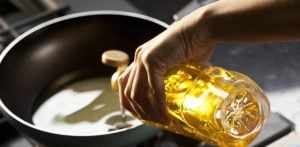There was a reduction in hair loss.
Amla oil is a staple in many South Asian bathroom cupboards.
The dark green liquid and pungent smell stand out in a crowd of hair masks and oils.
The oil is derived from amla fruit, also known as Indian gooseberry, a plant that has been used for centuries in Ayurvedic, Tibetan and Chinese herbal practices.
‘Maalish’ or massage, is a common practice in South Asian households, especially between females.
Mothers, daughters and other family members often spend time massaging each other’s scalps with hair oil.
Applying oil to the hair and body has recently been seen more in the Western world as a practice of self-care.
Abhyanga, an Ayurvedic practice which involves self-massage with hot oil, can help to promote lymphatic drainage, reduce inflammation and hydrate the skin.
Abhyanga can also be seen as a means of meditation – massaging yourself before a bath or bed can leave you feeling grounded.
Benefits of Amla Oil
 Scientists from Father Muller Medical College, India, argue that the products from the fruit can be used as a restoring agent, anti-inflammatory and hair tonic.
Scientists from Father Muller Medical College, India, argue that the products from the fruit can be used as a restoring agent, anti-inflammatory and hair tonic.
Others from Santosh Medical College, India, claim that Indian gooseberry is a “rich source of Vitamin C” and E, vitamins which are key for cellular regeneration.
The researchers also argue that the fruit is antimicrobial.
All these factors could also promote a healthy scalp as well as hair.
Therefore, it is clear why the fruit has long been used as the main ingredient in shampoos and conditioners and claims to promote hair growth and prevent grey strands.
Clinical studies from the Republic of Korea have also found that groups using amla oil saw a significant increase in hair growth compared to placebo groups.
Others from the US and India also found that there was a reduction in hair loss.
Amla oil can work with any hair type. Its benefits, as listed above, can help with overall hair health.
In particular, amla oil can work with all different wavy and curly hair types as it moisturises therefore keeping frizz and dryness at bay.
For example, those with 1 or 2 type curly hair – wavy, coarse hair – can benefit from amla oil to prevent breakage.
Amla oil can also be beneficial to 3 to 4 type curly hair – curly to afro – as its properties can help moisturise the hair and prevent frizz.
Scientists have not carried out studies on the benefits of consuming amla oil orally so it is not recommended.
However, the powder made from gooseberry could impact overall health.
A clinical study found that consuming amla oil over 18 weeks improved endothelial functions and reduced oxidative stress.
Side Effects
 Unfortunately, there is not a huge amount of research on the side effects of amla oil.
Unfortunately, there is not a huge amount of research on the side effects of amla oil.
However, before trying any new product it is always best to do a skin patch test in case of allergic reactions.
Drop a small amount of amla oil into your forearm and wrist and wait 24 hours to see if there is a rash or any redness.
If you react, don’t use the oil, and contact your doctor. If there is nothing, it is safe to use on your scalp.
Also, be wary when using amla oil on bleached hair.
As amla oil promotes pigmentation and prevents greying hair, the oil could darken blonde or bleached hair.
There are alternative amla oil products which you can use on coloured hair.
How to Use Amla Oil
 As a Pre-Conditioner before your Hair Wash
As a Pre-Conditioner before your Hair Wash
Before applying a mask to your hair, it is always best to detangle knots so that the treatment can spread evenly.
For extremely knotted hair, this might be difficult.
To do so without causing breakage, split your hair into sections and start combing out the knots at the bottom of the hair and work your way upwards.
The hair is ready for amla oil once all the knots are out.
Again, split your hair into sections using a clip or hair tie and take some amla oil into your hand. It’s always best to pour small amounts of amla oil at a time.
Once the hair is covered, you can also massage your scalp.
Pour a small amount of amla oil into your hands and rub your hands together before working on the scalp.
This can help to avoid dandruff and promote hair growth as it increases blood circulation in that area.
This is also amazing practise of self-care. Take a few minutes to work that oil into your scalp and de-stress.
After massaging your scalp, comb your hair out again to ensure the oil has spread evenly.
You can now leave the oil on your scalp for around 15 minutes minimum. Rinse out your hair with warm water and shampoo.
You may need to repeat the shampoo stage once after just so all the oil has been removed. Then follow with your usual conditioner.
As a Night Mask
You can also use amla oil as a night mask.
Although the steps are similar to using amla oil as a pre-wash treatment, there are extra steps to consider.
After detangling, and applying the oil to the hair and scalp, it is best to pin your hair up and place it into a plastic cap.
Popular amla oil products are coloured and the shower cap can be used to prevent any staining.
The following morning, rinse with warm water and shampoo.
Again, you may need to repeat applying shampoo to ensure all the oil has been removed.
You can then follow with your normal conditioner.
Amla Oil Recommendations
 Dabur’s Amla Hair Oil is the most popular in South Asian households.
Dabur’s Amla Hair Oil is the most popular in South Asian households.
Their products are affordable and the brand’s creation is rooted in Ayurveda practices.
Fable & Mane’s Purple Oil is safe for coloured hair.
A small amount can also be used on dry hair after hair washing, without needing to rinse out.
If you’re looking to consume amla orally, taking Fushi’s amla tablets twice a day could help with increasing antioxidants and vitamin C in your body.
Finally, if you’re in search of shampoo and conditioner which will thicken your hair, Aveda offers a set that contains 4 amla products which will exfoliate the scalp whilst promoting hair growth.
Many of us were lucky enough to have the time to carry out self-care practices such as hair oiling and masking many times a week.
In a post-lockdown world, it might seem overwhelming to schedule practices like these.
The beauty of hair oiling is that it can be carried out once a week and for 15 minutes minimum.
If you are on the go, you can also use oil, rather than gel, to tie up your hair in a sleek style and avoid flyaways.
Hair oiling may seem more popular now due to TikTok, and Pinterest, but it is a practice that has been carried out for thousands of years and will continue to do so.





















































 As a Pre-Conditioner before your Hair Wash
As a Pre-Conditioner before your Hair Wash








